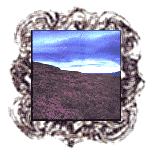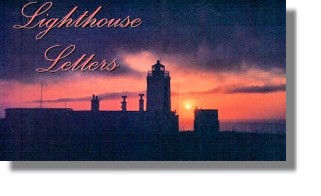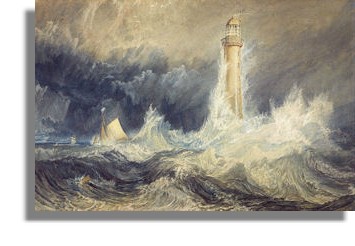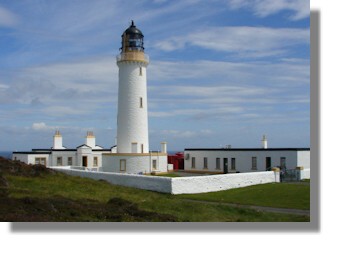

Lighthouse Letters
By Sharma Krauskopf
This is an article by Sharma Krauskopf from Michigan who fell in love with Scotland - and decided to buy a lighthouse keepers' cottage at Eshaness, a remote location in Shetland, in the far north of Scotland and live there each winter. These pages were previously part of the "Scottish Radiance e-magazine Web site which was created by Sharma.
Not, often do I stop to measure why something matters in my life unless someone asks or something brings it to my attention. Recently an email slipped onto my inbox with the title, "Lighthouse." Almost compulsive about answering my email especially those with the title "Lighthouse" I read it at once. It was from a reader in Ireland who loves lighthouses. Why Lighthouses?
He asked me the question, "Why lighthouses?" I wanted to flippantly declare "Why not?" except the writer is a lighthouse aficionado searching for an explanation for his fascination as well as my own. In my usual hasty email style I dashed off a list of words, which I associate with lighthouses as an answer. The question haunted me and to preserve my sanity it merited a complete answer. So here Rob, and all of the other lighthouse lovers who might read this column is a more comprehensive answer.
First, lighthouses are ordinarily found in remote areas with a small number of human neighbors. Neist Point (seen here in a graphic by S Parish via Wikimedia), which I have visited many times, has its nearest human beings a 45-minute walk away! Most Scottish lighthouses only next door neighbors are sheep. Many facilities can only be approached by boat so I guess their neighbors are fish.
My first reason, not necessarily the most important, is their remote location where I can be completely alone. At this time in my life that is a necessity since my life is hectic, full of deadlines and an assortment of chaos. I have a compulsion to be surrounded by nature but isolated where I can think and feel nothing if I like.
Second, all of the station's postal addresses could be "Ocean Place." Their relationship with the sea is an intimate one. Some are found on peninsulas surrounded on three sides by water. Others from on top of lofty heads view across miles of ocean. "Flat land lights" are situated where one can walk out the door and within a few feet are on the shore. Rock stations are usually the only buildings on small islands where the access is by boat. The air surrounding a lighthouse is fresh with the smell of the sea. The melody of the waves touching the shore is often the only sound you hear. Like classical music the wave's melody can be violent and loud or soft and peaceful. A valid reason for someone like me who lives on a farm surrounded by pastures is they are a stone's throw from the ocean. Our farm is beautiful but I continually yearn for the sea.
If you are a nature lover then a lighthouse is the best place in the world to experience ocean creatures in their natural environment. I have witnessed dolphins, whales, many different types of sea birds including puffins, and seals within a short distance of many keepers' houses. My favorites are the seals, which at most Scottish lighthouses can be seen through the windows playing outside on the rocks. The seal pictured here was photographed on Skye, via Wikimedia. Good fishing is a few feet beyond the house and there is nothing better than a lobster you have caught over the side of the lighthouse wall. Being close enough to a whale to hear the blow is sufficient reason for me to love all lighthouses.
The lighthouses are a part of history. If the towers could talk, they would relate an extraordinary saga of man and his ongoing relationship with the sea. They could tell of tragedy and triumph that have occurred in the world of water which surrounds them. Staggering tales of the courageous and devoted keepers' who kept the lights blazing or tragic stories of death and shipwrecks are forever chiseled in their hard stone exterior. (The graphic here is by Joseph Mallord William Turner via Wikimedia). Most of the lighthouses are historic building some dating back to the 1700s.
Many perceive lighthouses' buildings as physically beautiful. Surrounded by exquisite locations the nature of their architecture leads to feelings of majesty. The tall towers stretch out to touch the sky while brilliant beacons pierce into the black of the night. Even the Fresnel lens during the day time look like magnificent gold diamonds sitting in their towers with the light streaming through them to paint rainbows of color on the ground below. For many lighthouse buffs, beauty is the main reason they cherish these structures.
Due to changes in technology, lighthouses have in many places become unnecessary. They have gone from being lovingly tended by their keepers to the cold reality of being operated by machines through phone lines. Thank goodness, in Scotland the lights are still shinning and the properties maintained. In many parts of the world the lights have been shut off and the properties abandoned. In the state where I live we once had 247 lighthouses on the Great Lakes but now we have less than 100 in good condition. They have been allowed to decay and deteriorate. Tears come to my eyes when I think of something so historic and beautiful as Scotland's Duncansby Head being allowed to die a slow and hideous death. At least I know the Northern Lighthouse Board will not allow that to happen to Duncansby (see graphic from Wikimedia). If the property cannot be saved, they will destroy it quickly and finally. I relate this to how I feel when I know a good friend might die and the time we have left becomes so very valuable.
Having now given you some of the intellectual reasons I want to close with an emotional moment in my life which puts it together:
Snow is gently falling as we drive to the lonely peaceful car park a few hundred feet from Corsewall light (picture here adapted from one by W F Millar, via Wikimedia). Having had dinner with Tom Kelly, the occasional keeper for Corsewall, we were on our way to his house for a cup of tea but had made a short detour wanting to see the lighthouse up close in full night-time operation. Walking to a rocky viewpoint where the only sound was the crashing mad and angry sea below us, we looked back at the lighthouse. The beacon striking out from the tower was revolving in the snow. The light made long rays of silver narrow at the beginning and wider the further from the tower they penetrated the sky. Framed in the beam of light was the glitter of hundreds of twinkling speckles caused by the ice crystals in the snow. I once related this scene in another of my published stories to the blades of helicopter revolving in the night. That is an accurate description of their appearance.
As I wrote this article I remembered that night and realized to me it answered the question "Why Lighthouses." The beacon illuminating the snow was alone in the sky, continuing to keep the ships at sea safe, creating another moment of history among the hundreds of such moments since the lighthouse was built. Surrounded by the sounds of the sea that instant belonged only to the four of us. Each of us got back in the car with snowflakes mixing with our tears of wonderment accompanied with a deep feeling of total serenity. That is the best answer I can think of "Why Lighthouses?" and its memory will stay with me forever.
Return to Index of Lighthouse Letters or Index of All Guest Writers







